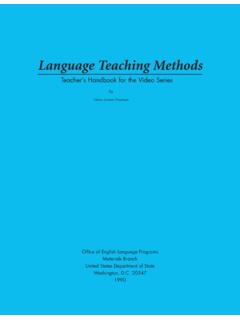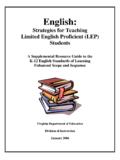Transcription of INSTRUCTIONAL MODELS AND STRATEGIES FOR TEACHING …
1 INSTRUCTIONAL MODELS AND STRATEGIES FOR TEACHING english LANGUAGE LEARNERSAni C. MoughamianMabel O. RiveraDavid J. FrancisTexas Institute for Measurement, Evaluation, and StatisticsUniversity of HoustonINSTRUCTIONAL MODELS AND STRATEGIES FOR TEACHING english LANGUAGE LEARNERSThe authors acknowledge the valuable assistance given byreviewers Nonie Lesaux, Charlene Rivera, Marjorie Rosenberg,Maria Helena Malagon, and Robert Rueda, and by AngelaPenfold and Elizabeth Goldman of the Center on publication was created for the Center on Instruction bythe Texas Institute for Measurement, Evaluation, and Statisticsat the University of Houston.
2 The Center on Instruction isoperated by RMC Research Corporation in partnership with the Florida Center for Reading Research at Florida StateUniversity; INSTRUCTIONAL Research Group; the Texas Institute forMeasurement, Evaluation, and Statistics at the University ofHouston; and The Meadows Center for Preventing EducationalRisk at The University of Texas at , design, and production services provided by RMCR esearch citation:Moughamian, A. C., Rivera, M. O., & Francis, D. J. (2009). INSTRUCTIONAL MODELS and STRATEGIES for TEACHING Englishlanguage , NH: RMC ResearchCorporation, Center on Center on Instruction and the U.
3 S. Department ofEducation retain sole copyright and ownership of this , the product may be downloaded for free from theCenter s website. It may also be reproduced and distributedwith two stipulations: (1) the preferred citation, noted onthis page, must be included in all reproductions and (2) noprofit may be made in the reproduction and/or distribution ofthe material. Nominal charges to cover printing, photocopying,or mailing are 2009 by the Center on Instruction at RMCR esearch CorporationTo download a copy of this document, visit INTRODUCTION2 Contextual factors3 Definitions3 Language vs.
4 Quality of instruction4 Guiding questions5 INSTRUCTIONAL MODELS AND PROGRAMS6 english -only model6 Structured immersion programs6 Sheltered instruction programs7 Bilingual model7 Dual language programs7 Transitional bilingual programs9 RESEARCH ON LANGUAGE OF INSTRUCTION11 INSTRUCTIONAL METHODS AND STRATEGIES12 The CALLA cycle of instruction13 english -only strategies13 Sheltered Instruction Observation Protocol (SIOP)14 Specially Designed Academic Instruction in english (SDAIE)15 Dual language strategies15 Bilingual Cooperative Integrated Reading and Composition (BCIRC)16 Improving Literacy Transitional INSTRUCTIONAL Program (ILTIP)20 IMPLICATIONS AND RECOMMENDATIONS23 REFERENCES29 APPENDIX A: INSTRUCTIONAL METHODS AND STRATEGIES32 APPENDIX B.
5 BILINGUAL COOPERATIVE INTEGRATED READING ANDCOMPOSITION (BCIRC) ACTIVITIESINTRODUCTIONS tudents identified as limited english proficient (LEP), also known in theliterature and in educational settings as english language learners (ELLs),represent one of the fastest growing groups among the school-aged populationin the Estimates place the ELL population at nearly 10 million students,increasing at a rate of more than 169% from 1979 to 2003 (NCES, 2004).Current projections place the proportion of english language learners at nearly30% of the school population by 2015 (Capps et al., 2005).
6 english languagelearners speak more than 400 different languages. Spanish, spoken by some 70 percent of ELLs, is the most common of these growing numbers of english language learners, states and schoolsface pressure to ensure that INSTRUCTIONAL practices for english languagelearners are effective and that these students make significant academicprogress each year. Students who have limited english proficiency receiveschool support under key provisions of the No Child Left Behind (NCLB) Act of 2001 ( Department of Education, 2002), which holds state educationagencies accountable for the progress of ELLs in two ways.
7 ELLs must meetAdequate Yearly Progress expectations for reading and mathematics under Title I and Annual Measurable Year Objectives under Title III. english languagelearners must demonstrate satisfactory progress in learning english and inattaining english proficiency on standardized content and language assessment some states (Arizona, California, Florida, and Massachusetts) havepassed laws detailing the types of educational programs available to Englishlanguage learners, others have not. Teachers who have not been trained towork with ELLs must make decisions about the types of INSTRUCTIONAL programsand STRATEGIES they will offer these students.
8 This publication seeks to offereducators and policy-makers guidance on STRATEGIES that have been effective in instructing english language begin by outlining key contextual factors that decision-makers shouldtake into account when making INSTRUCTIONAL choices for english languagelearners, then follow with a brief overview of bilingual and english -onlyinstructional MODELS . Finally, we consider the influence of the language ofinstruction on academic outcomes for english language learners. Regardless 1of the model that school districts select, teachers must use the most effectivestrategies to accelerate student learning and maximize INSTRUCTIONAL time; thispublication suggests research-based INSTRUCTIONAL STRATEGIES appropriate for arange of ELL INSTRUCTIONAL factorsMany factors make it difficult to develop a one size fits all model ofinstruction for this diverse group of students.
9 The characteristics and dynamicsof the student population, classroom, school, and community all affectappropriate program selection. Available empirical evidence and how it relatesto these variables should be considered when choosing and adjusting aninstructional program (along with additional STRATEGIES , MODELS , or instructionaltools used in the classroom). Contextual factors that may affect these decisionsfall within three main categories: (a) child and family characteristics; (b) INSTRUCTIONAL program features; and (c) socio-political and cultural considerations. Child and family factorsinclude a student s language knowledge (his or hernative language as well as english proficiency), socio-economic status(SES), acculturation into American society, the culture of American publicschool, age1of arrival, and immigration status (first or second generation).
10 Some students have developed literacy in their native language when theybegin instruction in english ; others have not. Each factor affects academicoutcomes independently and also interacts with the others in complexways to affect academic performance. INSTRUCTIONAL program featuresvary, as do the fidelity of programimplementation and teacher quality. All influence the effectiveness of any program. Socio-political and cultural considerationscolor the debates aboutappropriate instruction. State and federal laws and beliefs aboutcitizenship, immigration, and poverty complicate and influence instructionaldecision-making.










